Choosing a rooftop tent for your Toyota 4Runner can be a difficult decision. You are likely wanting a tent that won’t too negatively affect your fuel economy, is spacious, and versatile.
Investing in a hardshell tent for your 4Runner is the recommended route. Hardshell tents often offer more versatility as well as better aerodynamics when compared to a softshell tent. Tents like the iKamper BDV Solo or the CVT MT. Triumph are great places to start.
In this article, we will go over my 8 favorite RTTs for the Toyota 4Runner that will make your fellow campers envious!
4Runner RTT Comparison Chart:
| Weight | Mattress | Sleeping Area | Shell | Thickness When Closed | Lighting | |
| GFC Platform RTT | 135lbs | 2″ | 90″L x 50″W x 55″H | Hard | 6″ | N/A |
| Thule Foothill | 122lbs | not specified | 83.86″L x 46.46″W x 40″H | Soft | 9.45″ | N/A |
| Thule Basin | 176lbs | not specified | 81.1″L X 50.79″W X 35.83″H | Hard | 13″ | N/A |
| Roam Vagabond | 150lbs | 3″ | 56″L x 96″W x 52″H | Soft | 12″ | N/A |
| iKamper BDV Solo | 135lbs | 2.75″ | 90″L x 40.25″W x 59″H | Hard | 6.75″ | N/A |
| iKamper Skycamp 3.0 | 165lbs | 2.5″ | 83″L x 77″W x 58″H | Hard | 13.5″ | N/A |
| CVT Mt. Triumph | 163lbs | 2.5″ | 79.5″L x 47.5″W x 49″H | Hard | 7.75 | Interior LED |
| Alu-Cab Gen 3-R | 167.55lbs* | 2.95″ | 82.68″L x 51″W x 63″H | Hard | 11″ | Interior Reading Light |
1. GFC Platform RTT
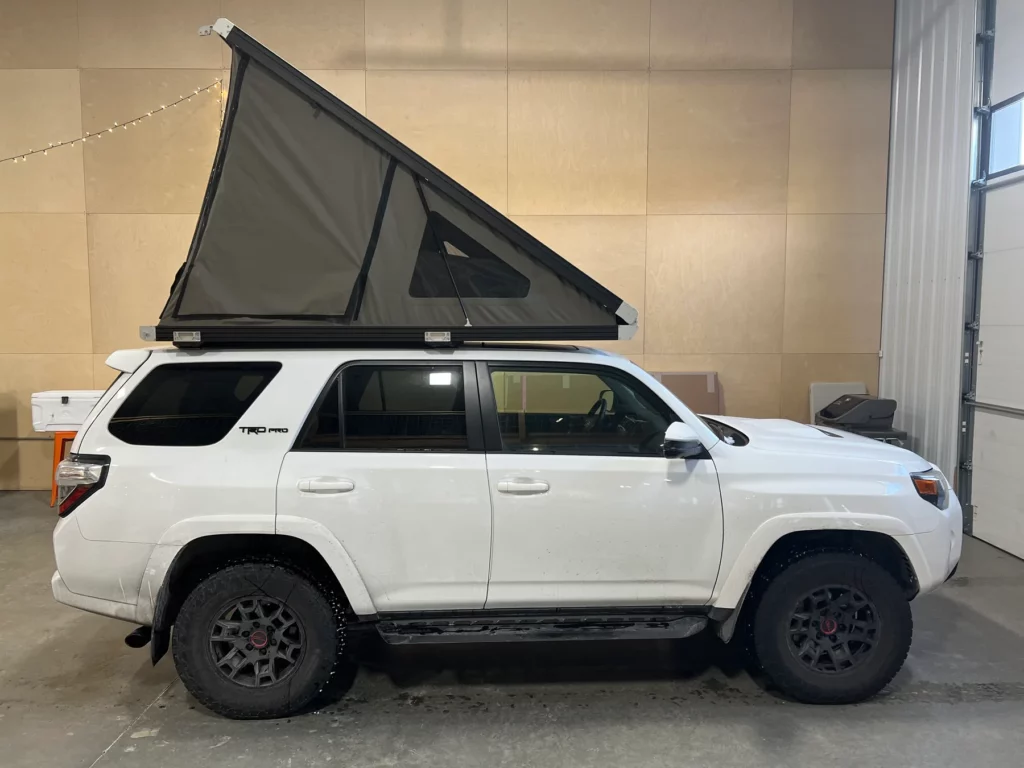
Detailed Specs:
| Sleeping Capacity: 2 person | |
| Dimensions Open: 90″ L x 50″ W x 55″ H | |
| Dimensions Closed: 97″ L x 53″ W x 6″ H | |
| Weight: 135lbs | |
| Mattress: 2″ | |
| Base: honeycomb composite | |
| Canopy: waterproof heat-welded vinyl | |
| Mosquitoes Screen: Yes | |
| Seasons: 4 |
Things to love:
Made in the USA! This tent is 100% made in Montana. It is one of the lightest hardshell RTT tents on the market as well as one of the thinnest coming in at only 6″ in height when closed!
The exterior of the tent sports t-channels all the way around it which allows you to mount additional accessories such as recovery boards, awnings, or even roof rack cross bars. With the addition of crossbars, the tent can support 75lbs when opened. That means you don’t have to take your bikes off your tent at every overnight stop. It means you can mount permanent solar panels. It means you have more freedom to pack for your adventure!
Also, an amazing feature for 4Runner owners is the fact that this tent is able to mount without any rack or crossbars! GFC has designed special brackets that mount straight into the predrilled bolt holes under the weather stripping. This allows the tent to sit only 1/2″ above your roof!
Things not to love (as much):
The first thing to note is, this tent does not include a ladder. You must purchase a ladder separately. With that said, being the smart 4Runner owner you are, you probably already have a Gobi Ladder mounted! So there would be no need for an additional tent ladder.
I would say the lack of a ladder is my only real complaint about this tent. However, in comparison to the other tents on this list, I would love to see them insulate the Platform RTT. While it is rated for 4 season camping, having a layer of insulation in there like others on this list would really bring it up the rankings.
Additional Accessories:
- Ladder
- Beef Rack Crossbar
- Universal Mounting Brackets
- PuffPad Mattress – an extra 3″ of sleeping perfection
- Solar Tray
- LP6 Light Mount
2. Thule Foothill
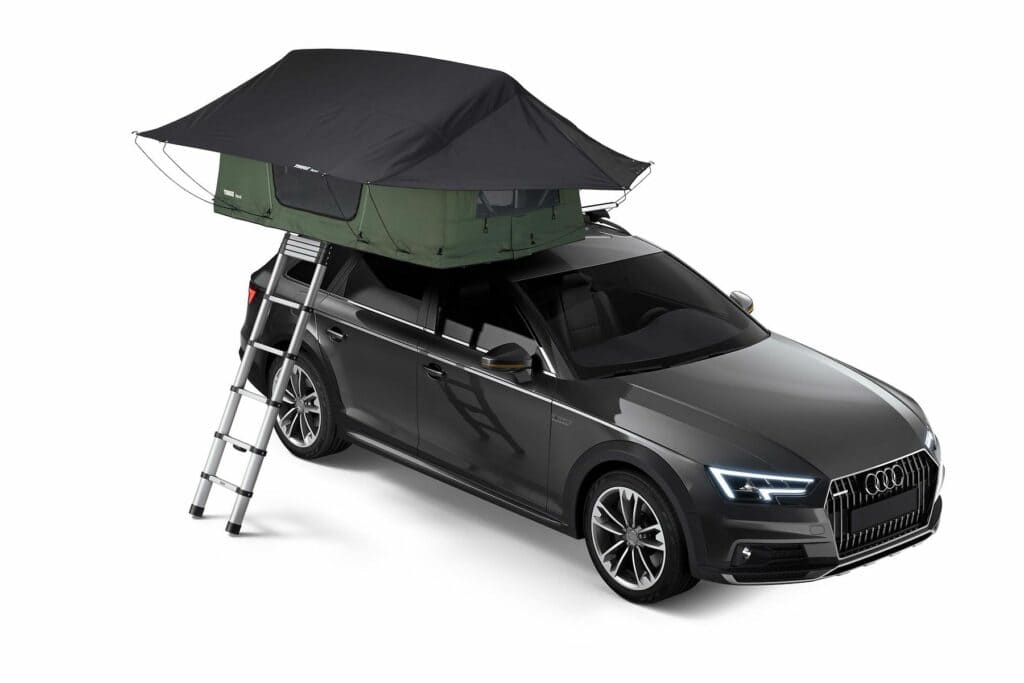
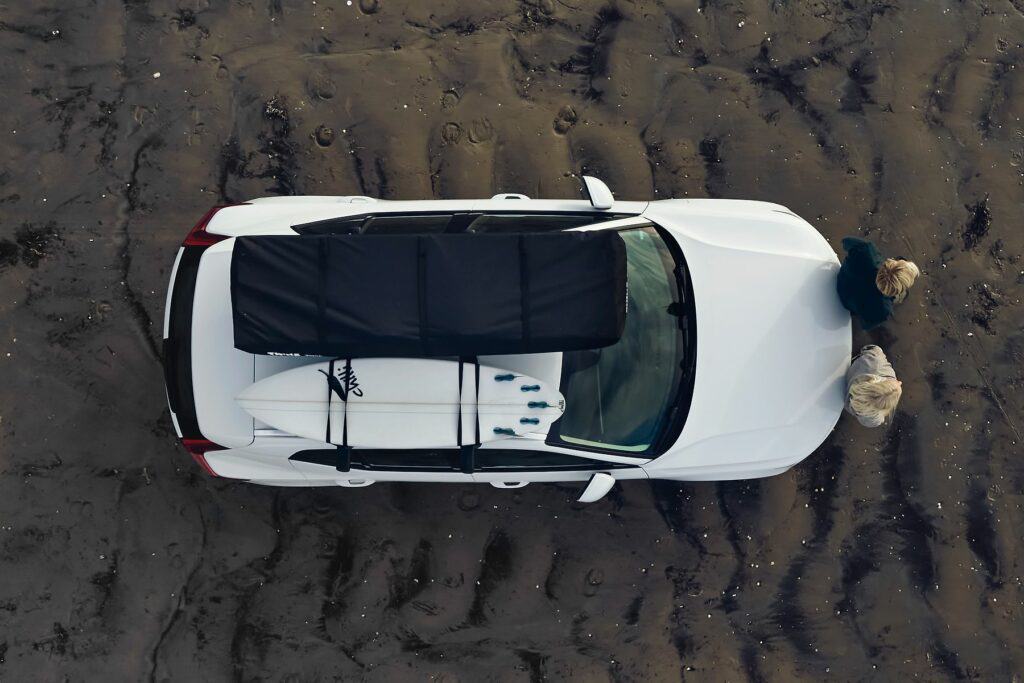
Detailed Specs:
| Sleeping Capacity: 2 person | |
| Dimensions Open: 83.86″ L x 46.46″ W x 40″ H | |
| Dimensions Closed: 82.99″ L x 24.02″ W x 9.45″ H | |
| Weight: 122lbs | |
| Mattress: Not Specified | |
| Base: Welded aluminum tube with insulation and aluminum cap sheet | |
| Canopy: Breathable, water-resistant 600D polyester ripstop 1500WP | |
| Mosquitoes Screen: Yes | |
| Seasons: 4 |
Things to love:
The Thule Foothill is a fantastic option for anyone who wants to be able to have a roof bin, bike/kayak rack, or simply leave half their roof available for whatever their heart may desire. With most softshell RTTs the footprint of the tent will cover the entirety of your 4Runner roof. This means if you would like to mount anything else to your roof you would need to either remove your RTT or have a hardshell tent that allows for items to be mounted on top of it.
Even though there are hardshell tents on the market (and this list), that allow items to be mounted on top of them, the items will be around 6-8″ higher than if they were mounted straight to a roof rack. That is the beauty of the Foothill – you still have half your roof rack available!
Thule also offers lockable quick-release mounts so that you can easily remove the tent if your vehicle is a daily driver and you’d like to keep it as streamlined as possible.
Things not to love (as much):
I would say there are 2 main things that I would consider minor drawbacks to this tent.
Weight:
Coming in at 122lbs, this tent isn’t the heaviest available, but it’s also not the lightest. I would love it if they could shed another 20lbs off.
Size:
Most softshell tents double their footprint in order to accommodate the height of an adult. Thule went a different route and constructed a tent that doubles its width to accommodate the average shoulder-to-shoulder width of an adult.
This means it is a true 2 person tent. Not ideal for a family or camper with dogs. Alternatively, a family could have 2 of these tents side by side. One for the parents and one for the kids. This might actually be preferred by some people versus a 4 person tent.
Additional Accessories:
- Boot Bag
- Double Boot Bag
- Quilted Insulation for those cold winter nights
- Tent Table – the idea of a tent table sounds a bit like a gimmick. Honestly, I would love one of these in my tent!
- Foothill Sheets
- Anti-Condensation Mat
- Security Nut System
3. Thule Basin
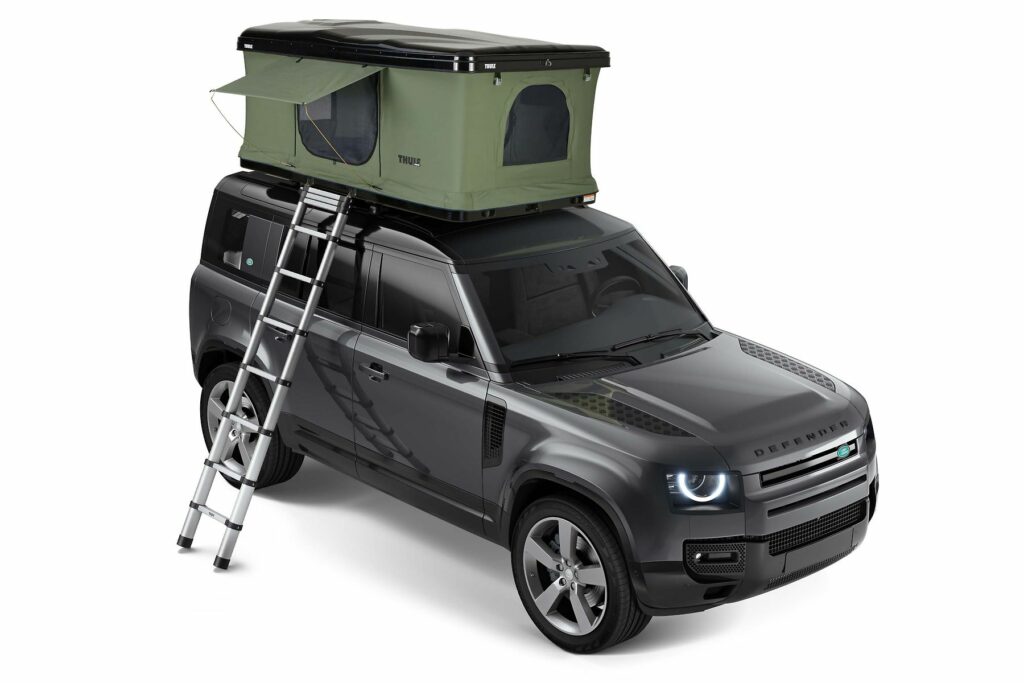
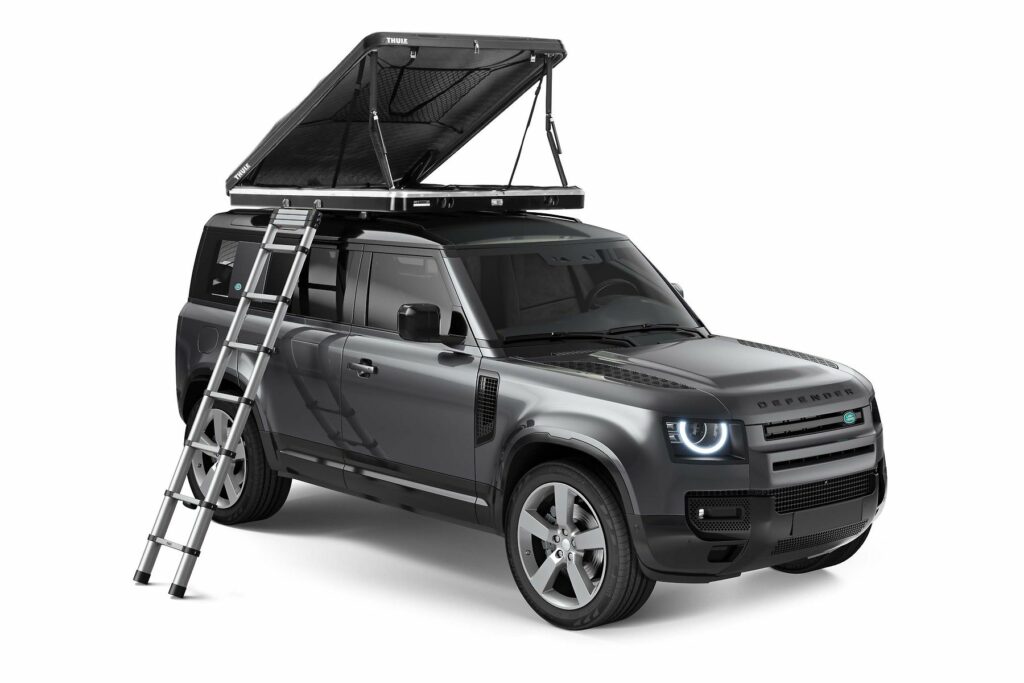
Detailed Specs:
| Sleeping Capacity: 2 person | |
| Dimensions Open (Interior): 81.1″L x 50.79″W x 35.83″H | |
| Dimensions Closed: 84.25″L x 55.12″W x 13″H | |
| Weight: 176lbs | |
| Mattress: not specified | |
| Base: ABS, and welded aluminum substructure with unique felt lined honeycomb polypropylene panels for reinforced support | |
| Canopy: 260g cotton and polyester coated to a waterproof rating of 1500mm | |
| Mosquitoes Screen: Yes | |
| Seasons: 4 |
Things to love:
The Thule Basin is a one-of-a-kind RTT. When you are not using it as an RTT you are able to remove the mattress and canopy – by doing this you can now use your Basin as a rooftop storage bin! This is great if you aren’t into winter camping. You can now throw your skis, snowboards, or muddy gear up into the bin and keep it out of your vehicle.
If you are looking for more headroom or simply like wedge-style tents better, the Basin is also offered in a Wedge version.
Things not to love (as much):
There are 2 main drawbacks that stand out to me.
The first one is the size of this tent when it is closed. When closed the Thule Basin is 13″ thick. That is more than double the GFC Platform RTT. 13″ of additional height on your 4Runner (not including a roof rack) is a lot of additional wind resistance, and you can also say bye-bye to most parking garages.
Keep in mind though, this converts into a 102.36″L x 52.36″W x 10.39″H rooftop storage bin. So even if you don’t use your tent much during the off-season, the bin still has a use.
Secondly, for the size of this tent, there isn’t a whole lot of interior height when this tent is open. If more height is important to you, click here to read about the Basin Wedge.
Additional Accessories:
4. ROAM Vagabond
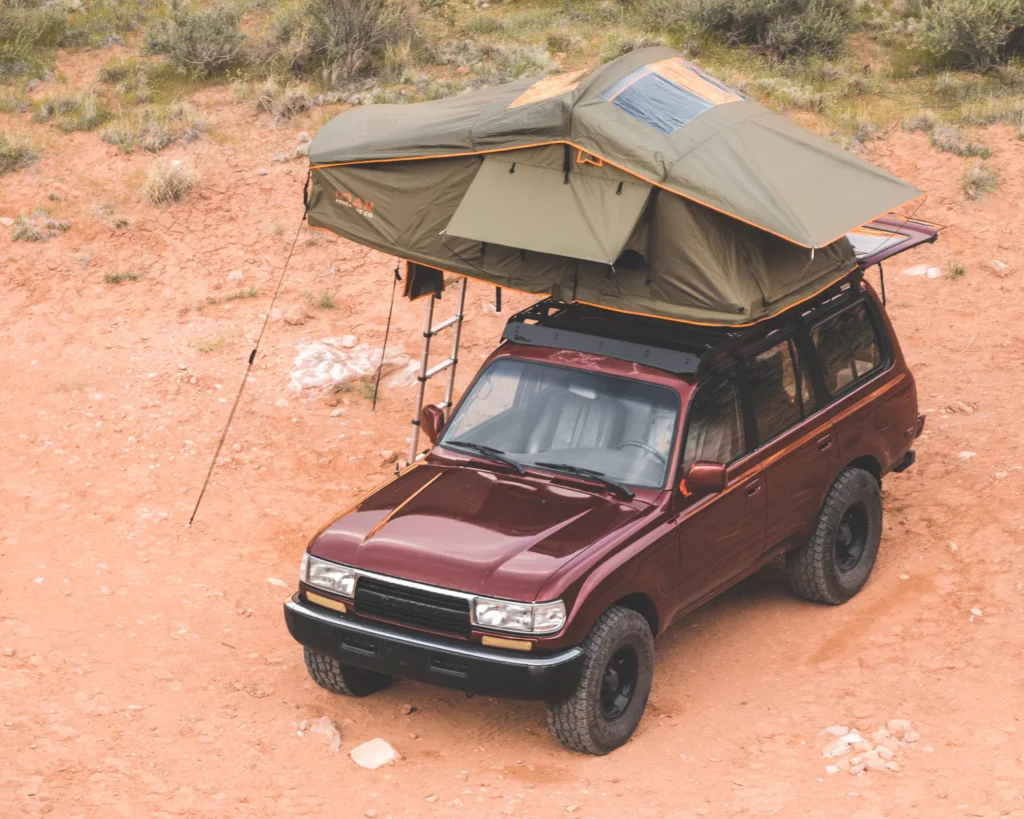
Detailed Specs:
| Sleeping Capacity: 2-3 person | |
| Dimensions Open (Interior): 56”L x 96”W x 52”H | |
| Dimensions Closed: 56″L x 48″W x 12″H | |
| Weight: 150lbs | |
| Mattress: 3″ thick high-density foam | |
| Base: insulated diamond plate | |
| Canopy: 280g ripstop poly/cotton, UV, water, and mold resistant – Rainfly – 600D PU-coated diamond rip stop nylon with 2 clear vinyl sunroof windows | |
| Mosquitoes Screen: Yes | |
| Seasons: 4 |
Things to love:
Roam has done an unreal job on the design of this tent. It has to be one of the best built and thought-out soft shell RTTs on the market. Everything about this tent is rugged – even its aesthetic. The warranty also backs its ruggedness – 5 years! They truly back and believe in their product.
We’ll start with the base. It is an insulated diamond plate, which means that it is as strong as they get. You won’t have to worry about washboard road vibration causing the mounting bolts to damage the base.
The base also has a “gear hammock” attached to it. In my opinion, this is a brilliant feature. When it comes to building a camping rig, the use of space is of utmost importance. Why waste an approximately 4.5-foot by 4-foot area when you could use it to hang your wet towels or store other light or soft goods while at the campsite?
The tent also comes with rubberized zippers which will be silent on a windy night, and not one, but two boot bags.
Things not to love (as much):
I would say that the only real downsides to this tent are the fact it is softshell and the size of it when it is closed.
These two things sort of go hand and hand as well. The size would not be as big of a deal if it were hardshell due to the fact that there are RTTs out there that you can mount gear to or inside of when it’s not in use. This tent is simply a large square sitting on your roof at all times.
The fact that it is softshell is definitely not a dealbreaker – I myself own a softshell tent. The downside of a soft shell tent is they take slightly longer to set up. Keep in mind though, a softshell tent will still set up faster than a traditional ground tent.
Additional Accessories:
- Ladder Soft Steps
- Mattress Sheet – offered in different finishes (waterproof, cotton, etc.)
- Tent Insulation
- Annex
5. iKamper BDV Solo
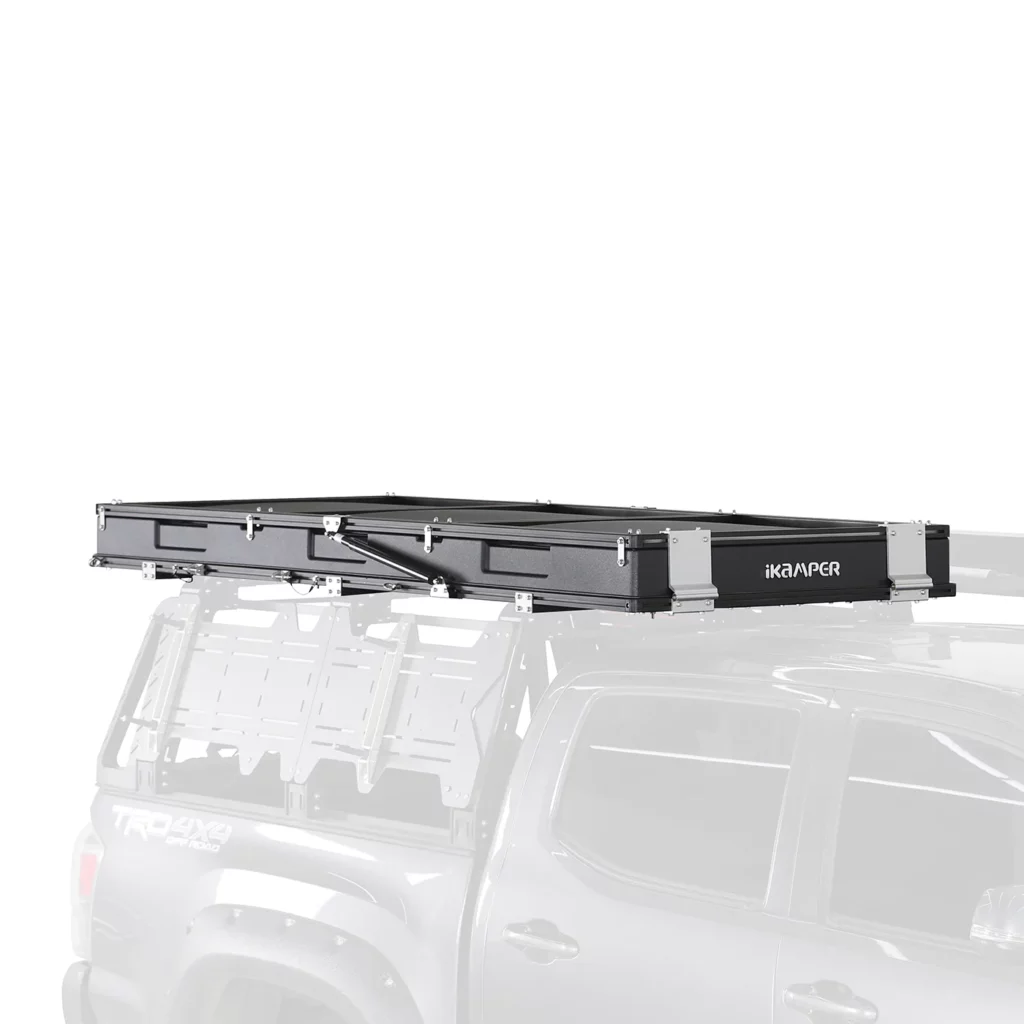

Detailed Specs:
| Sleeping Capacity: 1 person | |
| Dimensions Open (Interior): 90″L x 40.25″W x 59″H | |
| Dimensions Closed: 90″L x 40.25″W x 6.75″H | |
| Weight: 135lbs | |
| Mattress: 9-zone, 2.75″ thick, insulated polyfoam | |
| Base (Shell): Scratch/UV resistant Rocky Black FRP | |
| Canopy: Canvas sides with waterproof polyester 75D ripstop rainfly w/ eco-friendly water-repellent (DWR) coating | |
| Mosquitoes Screen: Yes | |
| Seasons: 4 |
Things to love:
The BDV Solo is a revolutionary tent in the iKamper lineup. Traditionally, iKamper’s have been on the bulky side. The BDV completely flips that narrative though, at an impressive 6.75″ thin, this is one of the most compact RTTs on the market. They also offer this tent in a DIY format if you’d like to save an extra couple of dollars.
One of my favorite features, much like the Thule Foothill, is how narrow the tent is. At only 40.25″ wide, it allows you to have half your roof rack available for other gear.
While the tent is impressively thin and narrow, they have not cut corners when it comes to quality and design. On the top of the tent, you are able to permanently mount a solar panel and run your cables into the tent or down to the ground when you are at camp. The tent also supports a weight of up to 100lbs on the roof when opened. Again that means if you have a bike or other gear mounted on top, you will not have to take it off at camp!
In 2023 iKamper will be releasing a full lineup of accessories specifically designed to mount to this tent. From storage bins to axes, it sounds like they won’t be missing anything!
Things not to love (as much):
This tent is narrow. While that is both a pro and con, iKamper has an answer to this – the BDV Duo! That’s right, they have a two-person version of this tent as well.
While they do have a t-track for the ladder mounting system, it does not appear that you are able to mount any awnings to the side of the tent like you can with the GFC and other wedge-style RTTs on the market. This of course may change in 2023 as they begin to offer more accessories.
Additional Accessories:
6. iKamper Skycamp 3.0
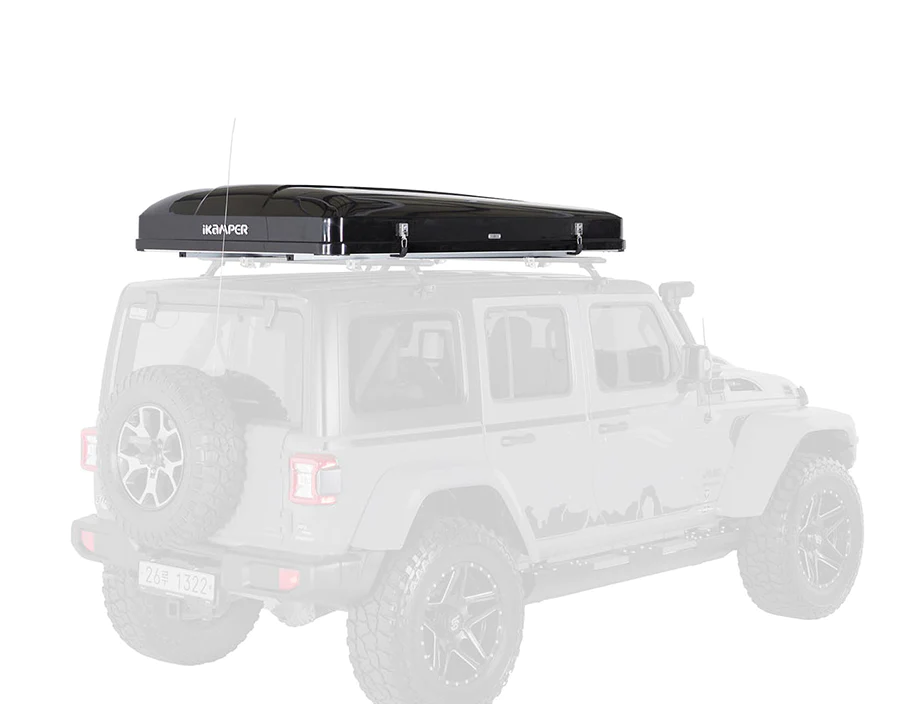

Detailed Specs:
| Sleeping Capacity: 4 person | |
| Dimensions Open (Interior): 83″L x 77″W x 58″H | |
| Dimensions Closed: 85.5″L x 55″W x 13.5″H | |
| Weight: 165lbs | |
| Mattress: 9-zone, 2.5″ thick, insulated polyfoam | |
| Base: Durable, insulating honeycomb aluminum panels | |
| Canopy: Breathable, black-out, 300gsm poly-cotton canvas | |
| Mosquitoes Screen: Yes | |
| Seasons: 4 |
Things to love:
The Skycamp 3.0 is iKamper’s flagship model. It’s the bees-knees. The cats-meow. It is one of the best tents on the market without question.
This tent is designed to be a true all-season tent. It is completely insulated from the base to the shell and interior “walls.” This is a tent you can comfortably sleep in all climates.
When opened, the mattress is king-sized! Weather it be a family of 4, a couple and some pets, or a solo person who wants to sprawl out, this tent has so much room for activities!
If you want to enjoy the king-sized goodness in total darkness, the Skycamp 3.0 will grant you that wish, courtesy of their blackout blind system.
Another fun feature about their window design is, if you’d like to retract the exterior window coverings, all you need to do is simply pull the two drawcords inside the tent and you will pull all the window canvas up out of the way. When it comes to a mid-day nap, you can let the cords down and you will quickly be in total darkness once again.
Things not to love (as much):
Unlike the BDV, the Skycamp 3.0 is neither thin nor narrow. It is a bulky tent. Once this tent is on your roof, it is there to stay and be a solo fixture. Of course, with the size comes the comfort that the interior provides, so it’s not all negative!
You are also unable to mount anything on the top of the tent or on its sides. This is something I would love iKamper to look into, as it would make justifying the size a bit easier.
If the BDV Solo/Duo doesn’t suit your needs and the Skycamp 3.0 is overkill for you, I highly recommend looking at the Skycamp 3.0 Mini.
Additional Accessories:
- Annex Plus – this is the king of all Annexes.
- Annex Plus Footprint – ever wanted to wear socks while sitting outside camping? This floor is for you!
- Annex Plus Vista Window
- Annex Plus Inner Tent – meant to easily divide up the annex into additional rooms.
- Insulated Tent – this is in addition to their already stellar insulation.
- Hanging Shoe Rack
- Hanging Storage Rack
7. CVT Mt. Triumph
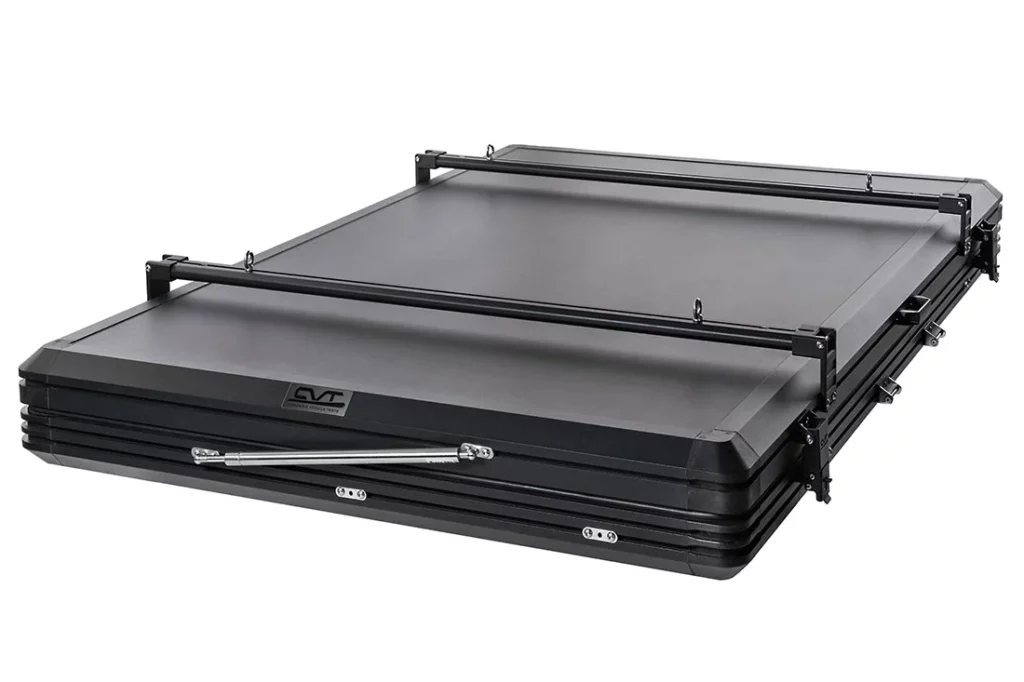
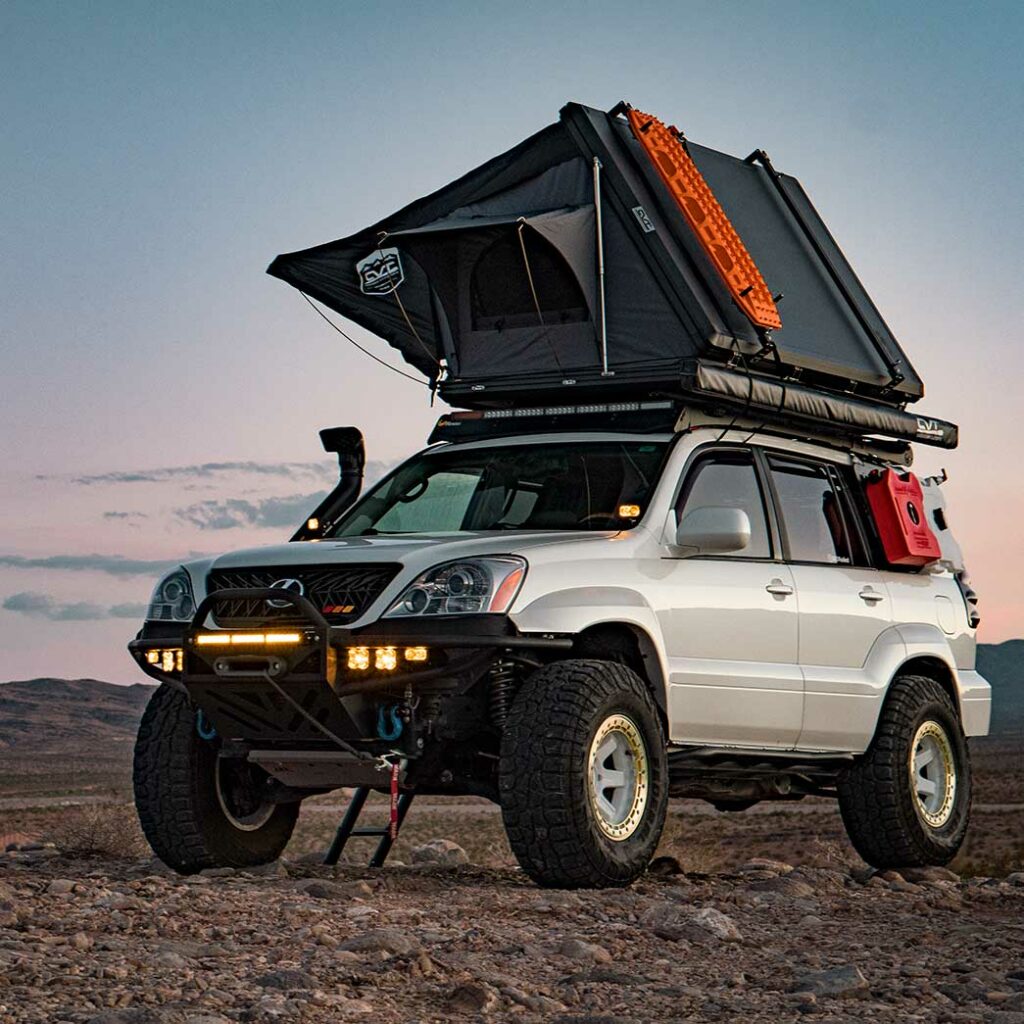
Detailed Specs:
| Sleeping Capacity: 4 person | |
| Dimensions Open (Interior): 79.5″L x 47.5″W x 49″H | |
| Dimensions Closed: 82.75″L x 51″W x 7.75″H | |
| Weight: 163lbs | |
| Mattress: 2.5″ | |
| Base: Aluminum | |
| Canopy: 280g Ripstop poly/cotton rip-stop canvas | |
| Mosquitoes Screen: Yes | |
| Seasons: 4 |
Things to love:
One of the first things I noticed about this tent that I love – an annex, an 8-foot ladder, and 2 shoe bags are all included! I love a brand that is willing to include the little things that will make your RTT experience that much better, without an upsell.
Because those things are included I would be much more inclined to splurge on a traditional awning or shower awning. How would you mount these awnings you ask? Along the t-track of course! The t-track encompasses all sides of the tent. Allowing you to mount accessories to the sizes, or even cross bars along the top.
Honestly, at this point, I don’t know why a brand would design a hardshell tent without a t-track around it.
The Triumph is also one of the only hardshell tents on the market that includes a “stargazing” window. I think everyone knows already that those stargazing windows are nearly impossible to see out of at night, but it would be great for allowing natural light into the tent during the day if that is something you wanted.
Lastly, the Triumph includes a LED light. Once again this is one of those small details that I love to see. Sure a headlamp or lantern will do the job, but having a dedicated light up in the tent can be a game changer. You don’t need to try and balance your lantern or blind your partner as you directly look at them while wearing your headlamp on full power.
Things not to love (as much):
Honestly, there isn’t much not to love about this tent. If I were really looking for something, I would say the size. While it does have a large footprint, it is only 7.75″ thick when closed, and offers the t-track so you can still mount accessories to the side of it or on top of it.
It is also not an insulated tent. Again though, in my opinion, that is a luxury, not a necessity. Plus, a good quality sleeping bag or a diesel heater would solve that issue.
Additional Accessories:
8. Alu-Cab Gen 3-R
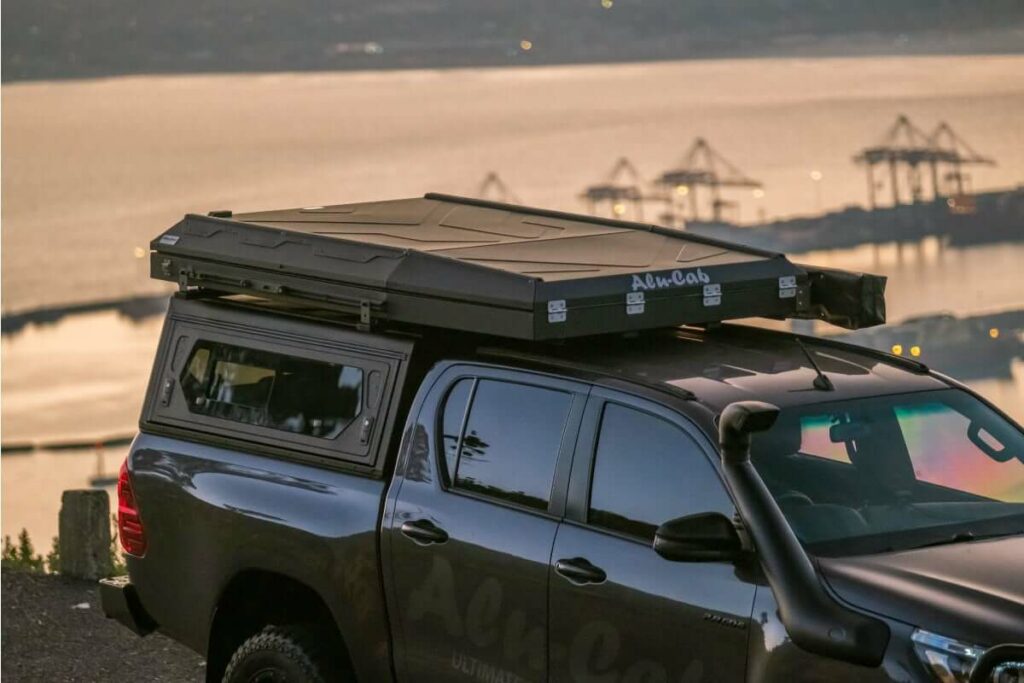
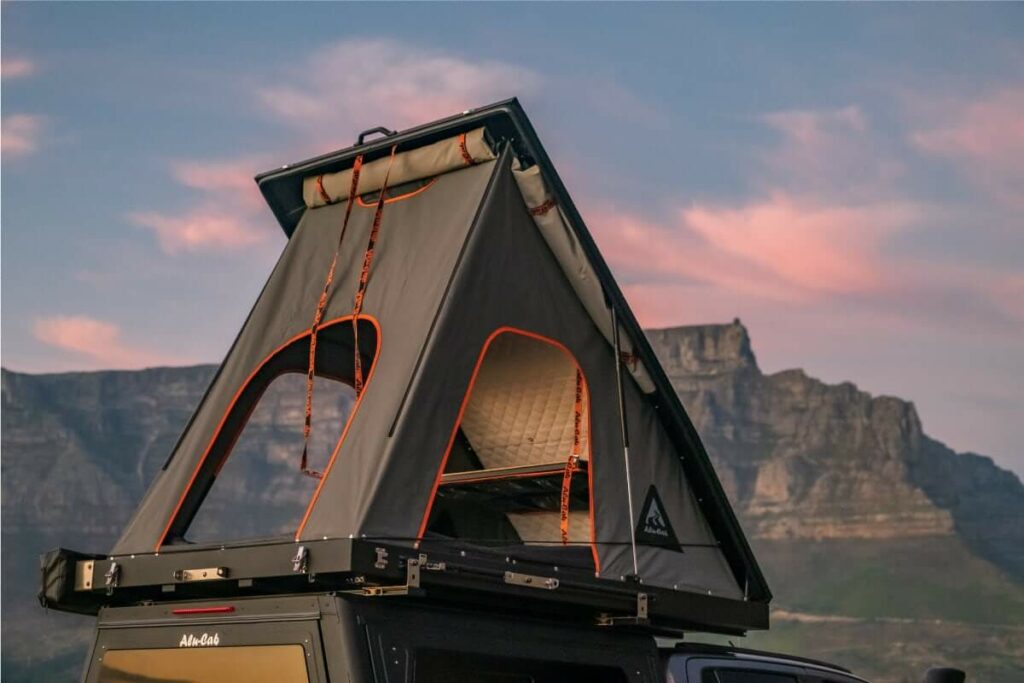
Detailed Specs:
| Sleeping Capacity: 2 person | |
| Dimensions Open (Interior): 82.68″L x 51″W x 63″H | |
| Dimensions Closed: 90.55″L x 55.12″W x 11″H | |
| Weight: 167.55lbs | |
| Mattress: 2.95″ | |
| Base: aluminum – with an insulated lower and upper shell with closed-cell foam lining. | |
| Canopy: Dual-layer canvas | |
| Mosquitoes Screen: Yes | |
| Seasons: 4 |
Things to love:
The Alu-Cab Gen 3-R… the definition of “tell me you Overland, without telling me that you Overland.”
The Gen 3-R is packed with features and has some awesome add-ons. We’ll start with the t-channels that you are probably getting tired of me mentioning. They do not go all the way around the tent like some of the others on this list, but they are in strategic and useful locations.
In order to mount crossbars onto other tents on this list you must use up a portion of your t-channel on the side of the tent. Alu-Cab has actually put dedicated channels on the roof of the the tent. These can be used for things such as crossbars and solar panels.
Speaking of solar panels, one of Gen 3-R’s best features is the fact that it comes prewired for solar panels. It is literally plug-and-play. There is a spot on top of the tent plug in your panel(s). Meanwhile, inside the tent, there is a 12-volt socket, USB charging ports, and a reading light.
The tent is also completely insulated. From the shell to the quilted interior, you are protected from both the heat and the cold.
Another way to beat the cold is with their side vent which is designed to allow a diesel heater to be piped through! This tent is truly an expeditioner’s dream.
I will link these below, but they also offer a table for in the tent, as well as a brace that allows you to prop the mattress upright in the tent in case you want to comfortably sit and take in the views!
Things not to love (as much):
Like the CVT Mt Triumph, there isn’t much to not like about this tent. It is extremely well thought out.
With the well thought out design and technical features this tent offers, it also comes at a very premium price. If you are someone who camps or Overlands a lot, the price could very well be worth it though. This is not the tent for the person that camps 4 times a year. Unless you have money burning in your pocket of course! I’m not your financial advisor, just here to tell you about awesome gear!
Additional Accessories:
Do Rooftop Tents Use More Fuel?
The simple answer to, do rooftop tents use more fuel is, yes. The more complicated answer has to do with the shape, weight, and method to which the tent is mounted.
For example, the GFC Platform RTT mounted directly to the roof of your 4Runner will be more streamlined and cause less drag than an iKamper Skycamp 3.0 mounted onto a roof rack.
An alternate option you could look at is an Overlanding trailer that is meant to have a rooftop tent mounted onto it, or build yourself a u-built trailer to mount your RTT. Whether or not this would save fuel on a trip when compared to having your tent on your roof is debatable. However, when you are at home and daily driving, not having your tent mounted to your vehicle will definitely save on fuel!
And of course, you can always just take your tent off your roof when you are at home, but if you camp often taking your RTT on and off your vehicle would become a hassle.
Can You Put a Rooftop Tent on a Factory Roof Rack?
In theory, you can put a rooftop tent onto the factory roof rack of a (5th gen) Toyota 4Runner, however, it is not advised.
Toyota’s recommended weight limit for the rack (this is different than the roof’s rating) is 120lbs. Most tents on the market are heavier than that, with a few exceptions.
Rooftop tents can be expensive investments, protecting that investment by mounting it to a proper rack is a wise idea. I would highly recommend the Greenlane Offroad roof rack system, or a Prinsu Rack.